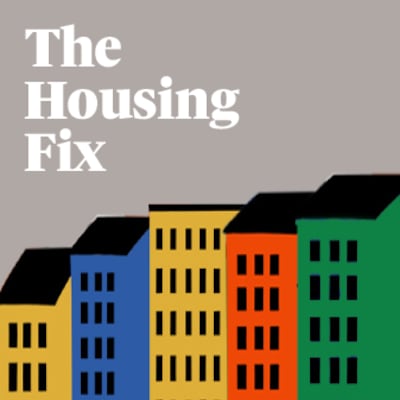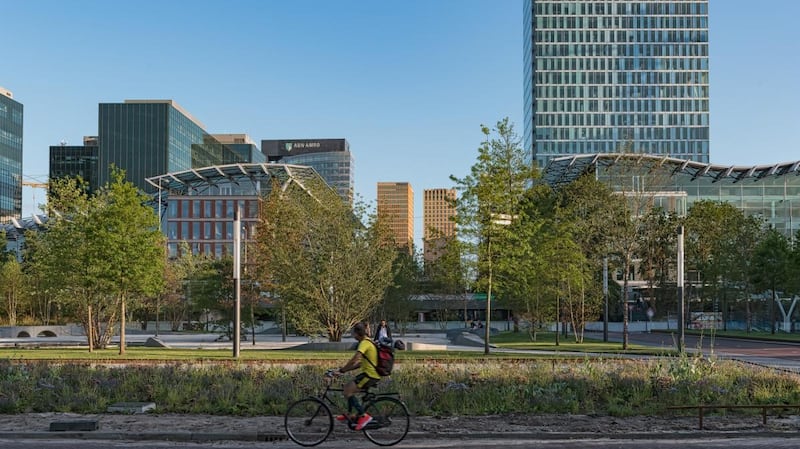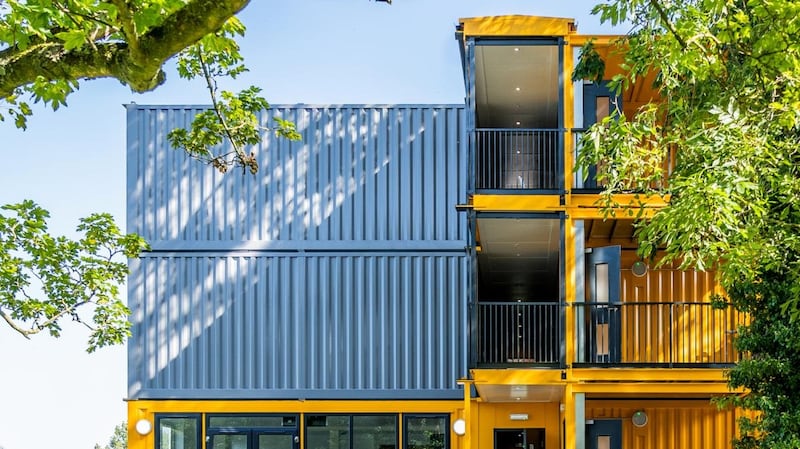"The Housing Fix" is an Irish Times series exploring solutions to Ireland's housing crisis – arguably the biggest social and economic issue facing the country and its next government – in the run-up to the general election. For more, read Cliff Taylor's 12-step plan of action, David McWilliams's economic analysis and our voter's guide to the parties' housing manifestos.
LOW-COST RENT
Vienna, Austria
Among the most discussed ways of improving outcomes for renters is the so-called “Vienna model”. Roughly based on a type of tenancy popular in the Austrian capital, the model is based on what is called “cost rental”.

In a cost rental model, the rent paid by a tenant is based on the cost of supplying the building and covering ongoing cost, rather than including a profit margin. Those who cannot afford such a rent level are often given housing subsidies to live in the development.
Under a cost rental model, the buildings are constructed by housing associations, often with support from state-backed or brokered low-cost loans, which reduce the cost of financing the development, leading to more affordable rents. As servicing the debt gets cheaper, ultimately resulting in the loan being paid back, equity generated in the project can be used to build more developments.
Under the Austrian system, tenants can also acquire rights, and some schemes allow tenants to purchase their apartments outright if they have the means. The housing association then recycles the funding into other schemes.
Ireland is beginning to experiment with cost rental – a 155-unit development by Respond and Tuath housing associations, with Dún Laoghaire-Rathdown County Council and the Housing Agency, will have some 50 two-bedroom cost rental homes.
However, some Opposition TDs, including Sinn Féin’s Eoin Ó Broin, have queried whether the rent to be charged – €1,200 per month – is affordable. He has suggested that a truly affordable level of rent for a household whose income is between €40,000 and €70,000 would be between €700 and €900 per month.
The other wrinkle in cost rental is simply the amount of time it takes to become effective and self-perpetuating. Housing associations become more effective as the loan finance is paid down, which takes at least a decade. Meanwhile, the planning process and development timelines mean it will be two years or more before a scheme signed off on today comes on stream.
As Rosalind Carroll of the Residential Tenancies Board points out, other countries started working on concepts like this after the second World War. “We have a period where we have to catch up now”.
Jack Horgan Jones

THE GREEN SPACE DEBATE
UK, California, Germany
It is 20 years since Irish economist Colm McCarthy observed in this newspaper that there are “an awful lot of green blobs” on the map of Dublin. McCarthy suggested that some of the capital’s parks and green zones be used for residential development in a city that was then, as now, wailing for accommodation.
When he suggested building on the 240-acre St Anne’s Park in Raheny, one reader wrote a letter wondering if McCarthy’s intervention was an April Fool’s joke. But was the wider idea really such a crazy one?
Just over two years ago, similar sentiments were put forward by Owen Keegan, chief executive of Dublin City Council, who pointed out that 26 per cent of the capital’s land is zoned for open space, green buffers where building is prohibited. Some of these were underused and offered little amenity value, he said. Better to build homes on parts of them and upgrade the remainder for better community use.
This, too, was shot down. But, increasingly, in other developed countries where housing crises are biting, the unthinkable is being considered.
Britain pioneered the use of city-constraining green belts in the postwar years, and they remain central to its spatial policy. The buffer around London is bigger than the city itself, and many blame it for stratospheric house prices. In 2018, a delegation of MPs approached former UK prime minister Theresa May asking her to relax the rules. She refused.
There was a similar debate in Germany, where in 2017 a new zoning status was instead created to allow higher-density construction. California recently implemented rule changes along similar lines.
Critics will say that green zones are the city’s lungs. But would the Earth stop spinning if a few slices around the edge of the Phoenix Park were set aside for city housing? It didn’t when the 100-acre Phoenix Park Racecourse was hived off during the last property boom.
McCarthy’s 20-year-old idea for St Anne’s seems revolutionary when you consider the situation there now. A proposal by developer Pat Crean to build 650 units in fields beside – not in – the park fell foul of a court action a year ago by local residents, who feared their walking amenity would be overlooked.
As Keegan said two years ago, Dublin needs homes but existing homeowners will not support the measures needed to supply these homes.
Mark Paul

HIGH-DENSITY PLANNING
The Hague, The Netherlands
The secret of successful high-density housing is not just imaginative urban planning based on sustainability. It’s about the integration of land use and transport design to make the most of the space you’ve got. And nobody does that better than the Dutch.
If ever you’ve travelled by train in the Netherlands chances are you’ve noticed that most of what you saw from your window was countryside, not urban sprawl.
That’s because, with a population of just over 17 million in a country roughly the size of Munster, space has always been at a premium. What’s known as its “green heart” is jealously guarded. Land is never wasted.
This convinced Dutch planners in the 1970s that it made no sense to adopt the seductive US model of urban life appearing on Europe’s television screens – featuring large automobiles, endless highways, and urban conurbations dotted with shopping malls linking one town to the next. The Dutch alternative was to plan new urban development and infrastructure where it made most sense.
Stakeholder agreement was crucial, of course. But in design terms, of primary importance was to ensure that any substantial new development was tied into the rail network. This had two effects. The first was that car use was confined largely to local journeys that couldn’t be done by bicycle.The bulk of daily journeys were by public transport.
In addition, housing and commercial property demand focused naturally on the transport “hubs” – the main stations or switching points between rail, tram and bus, for instance. The result was high-density housing, typically with a smaller “footprint”, led by consumer demand.
And because it became desirable to live within walking or cycling distance of your local station, urban sprawl led by car use was substantially reduced – as were CO2 emissions.
These concepts are not new to Ireland. They were part of A Platform for Change, the pioneering land use and transportation plan produced by Dublin Transportation Office, a forerunner of the National Transport Authority, under its now retired chief executive John Henry. That report fell victim to a dearth of technical understanding at political level, piecemeal implementation and lack of funding. What needed to be done then still needs to be done now.
Peter Cluskey
LONG-TERM RENTING
Belgium
Belgium is famous for its bureaucracy and appalling customer service, but when it comes to housing it boasts a well-functioning, affordable and well-supplied rental market. If you want people in Ireland to consider renting longer term, three characteristics are absolutely essential.
First, you need to give people security of tenure and a feeling of long-term commitment. In Belgium this is achieved though standard three-year or nine-year leases. Deposits are generally three months’ rent and are paid into a blocked bank account of which both the tenants and owners are co-signers.
The deposit can be accessed only by agreement among all parties. Leases are automatically rolled over and it’s not unusual to spend 20 or 30 years in the same property. Properties here are generally unfurnished (we even had to buy our own fridge and dishwasher), which enables tenants to take a longer-term perspective on their living arrangements.
Second, pricing is absolutely key. Monthly rent must be cheaper than the equivalent mortgage payment. The discount reflects the fact that you are renting a property, not paying for ownership in incremental stages.
In the Belgian university city of Leuven, my monthly rent for a three-bedroom house is about 30 per cent cheaper than the equivalent mortgage payment. Tenants here don’t live in fear of huge increases in rent every year. Rents are inflation-linked, and salaries are also adjusted each year to take account of prevailing inflation rates.
Third, rented properties – particularly apartments – must be liveable for families. In Belgium, that generally means dual aspect, dedicated basement (and often attic) storage space and an overall footprint significantly in excess of Irish norms. Building cheaper, smaller apartments will do nothing to encourage families to embrace apartment living.
Linked to this is the importance of building apartments near city and town centres, local parks, playgrounds, schools and transport. Unfortunately, in Ireland we seem to excel at out-of-town apartment developments sadly marooned in an sea of road-based inaccessibility.
Eoin Drea
Eoin Drea is a senior researcher at the Martens Centre, Brussels

CONTAINER LIVING
Bristol, UK
In a rising rental market those who suffer most are always those on lowest incomes. In Bristol, three of these groups – students, key workers and young homeless people – have been brought together to live in LaunchPad, an initiative of the Bristol Housing Festival.
The 31 shipping container-style (but actually purpose-built) studio apartments were built in just six months in on a disused council car park, with the first residents moving in last September. The project cost in the region of £1.5-£1.7 million.
The students and key workers – largely working in the health and education sectors – pay an average of £120 a week, with the young people, who are largely moving on from supported homeless accommodation, paying a social housing rent. A typical student rent in Bristol is £650 a month while market rents are about £1,000 for a one-bedroom apartment.
The project is a collaboration of Bristol Students’ Union, youth homeless charity 1625 Independent People and housing association United Communities.
The student tenancies are for one year, while the other tenants have a two-year agreement but, United Communities operations director Dave Bull said, tenancies will be renewable for all groups.
“We will give the option to extend because if we have a settled community we want to keep that together.”
Each studio is en-suite and equipped with a small kitchen, but there is also a larger communal kitchen and living room, which Bull says is an integral element of the scheme.
“The idea is people will get involved in social events and offer peer support. It’s not mandatory but we try to encourage it, particularly for the younger people to gain experience and confidence. It’s already happening organically and I think a large part of that was because no one was ‘placed’ here, everyone living here applied and bought into the concept.”
Olivia Kelly















